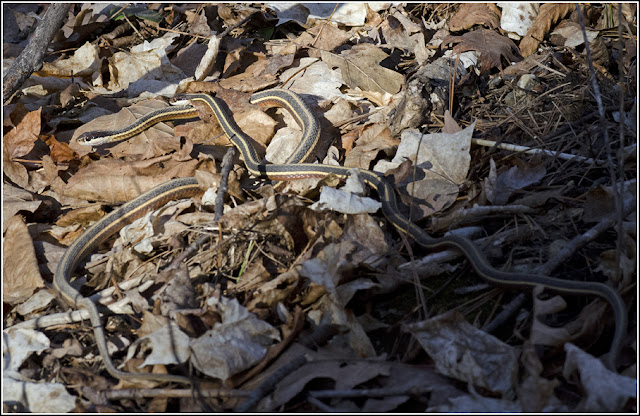I have been catching up with a ton of photo editing from earlier in the year recently, and I thought I would make a few posts with some of these odds and ends.
Way back on April 11 I visited a favorite location of mine. As a teenager I spent many evenings after school and mornings during the weekends to explore the swath of Carolinian woodland that covers the hillsides. Over the years I have figured out where many of the 25 species of reptiles and amphibians that live here can be most easily found. Northern Ribbonsnakes, a species at risk in Ontario, are relatively common here and on many visits they even outnumber Eastern Gartersnakes. Several of the south and west facing hillsides contain hibernacula, and on warm days as early as mid-March it is possible to find snakes basking in the warm rays.
April 11 was my first opportunity to visit this year. I was greeted by several Mourning Cloaks, often the first butterfly that I encounter in the spring. Adults of this species overwinter and by March they are not too difficult to find, if the weather cooperates of course. While most butterfly species feed on the nectar from flowers, Mourning Cloaks prefer tree sap, enabling them to survive this early before most flowers have emerged.
 |
| Mourning Cloak |
Eventually I came across a large female Northern Ribbonsnake. As I was observing it a rustle in the dead leaves announced the presence of a male, while a second male was not far behind. Eventually one of the males followed the pheromone trail left by the female and sidled up next to her.
 |
| Northern Ribbonsnakes |
After a few minutes of observation I gave them some privacy.
 |
| Northern Ribbonsnakes |
Next up are some photos from my time at Pelee this past spring. While I have posted about most of the highlights, some of the photos I had dropped into folders on my computer and forgot about until recently. First up is a pair of Barn Swallows, seen perching on some of the large boulders near the tip of Point Pelee in late April.
 |
| Barn Swallow - Point Pelee National Park |
Blue-gray Gnatcatchers migrate through mainly in late April, though quite a few will stay to breed in the park. This individual which I photographed on April 25 is an adult male, due to the bold black "eyebrows" it shows.
 |
| Blue-gray Gnatcatcher - Point Pelee National Park |
Anyone who has visited Point Pelee on a frequent basis has certainly ran into Raccoons at one point or another. As a birder who is constantly scanning the trees for birds, I often see them sleeping it a crook of a branch. This one was out strolling around, hoping for a handout!
 |
| Raccoon - Point Pelee National Park |
 |
| Raccoon - Point Pelee National Park |
On May 1 I made a stop at the Blenheim sewage lagoons while driving down to Point Pelee on the weekend. Good numbers of shorebirds were in, including these Dunlins. The individual in the rear is more advanced in its pre-alternate molt, showing some orange in the scapulars and coverts (wing feathers on the back) and the beginning of a black belly patch. The foreground individual is still mostly in basic plumage.
 |
| Dunlins - Blenheim lagoons |
Previously, a pair of Baird's Sandpipers had been discovered at the lagoons by Jean Iron. I was happy to see that they were both accounted for in the mostly dry sprinkler cell, though they were a little distant for good photos. While Baird's Sandpiper is an uncommon but regular autumn migrant through Ontario, it is very rare during the spring as their migration takes them north through the Great Plains. This was only the second time that I had observed a spring Baird's in Ontario.
 |
| Baird's Sandpipers - Blenheim lagoons |
On May 3rd I came across one of the Eurasian Collared-Doves in Leamington, sitting on a telephone wire at the usual location. They had been present since August, 2014.
 |
| Eurasian Collared-Dove - Leamington |
An adult Summer Tanager had been found by Lev Frid near the tram loop when I was at the tip that morning. I had plans to walk up to the Visitors Centre through that area anyways, so I searched for the tanager with several others. It eluded our cameras for a while but eventually perched up on some Vitis vines for a few seconds. The majority of the Summer Tanagers that we see in Ontario are duller orange or yellow-green females and young males, so it is a rare treat to have great views of a bright red adult male!
 |
| Summer Tanager - Point Pelee National Park |
Later that day I decided to check out Kopegaron Woods located west of Wheatley, because it was very slow for birds at Point Pelee. Often Kopegaron has a good variety of warblers and I recall seeing Worm-eating and Connecticut there last year, both of which were found by Jeremy Hatt. The birding was pretty decent this time around and I had about 10 warbler species in an hour. This Blue Jay paused nearby, providing my first decent photo of one perched.
 |
| Blue Jay - Kopegaron Woods |

No comments:
Post a Comment